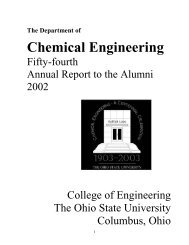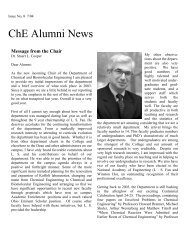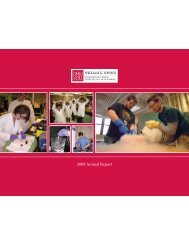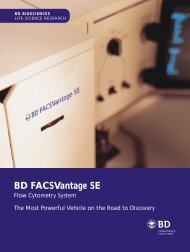2008 Annual Report - Chemical and Biomolecular Engineering ...
2008 Annual Report - Chemical and Biomolecular Engineering ...
2008 Annual Report - Chemical and Biomolecular Engineering ...
Create successful ePaper yourself
Turn your PDF publications into a flip-book with our unique Google optimized e-Paper software.
Graduate Program Ranking<br />
The latest U.S. News <strong>and</strong> World <strong>Report</strong> rankings of engineering graduate programs<br />
placed the Lowrie Department of <strong>Chemical</strong> <strong>and</strong> <strong>Biomolecular</strong> <strong>Engineering</strong> at<br />
#27. The College of <strong>Engineering</strong> was ranked #29 in the nation. While the college<br />
rankings are based in good part on objective measures such as research funding,<br />
number of PhD graduates, number of publications, etc., the departmental rankings<br />
are based on subjective surveys of deans of engineering <strong>and</strong> industrial executives. In<br />
2009, we expect the National Research Council to publish a listing of departmental<br />
rankings that will be more quantitatively based. We have submitted our data for<br />
the NRC exercise <strong>and</strong> are guardedly optimistic that our department will receive a<br />
higher ranking from that analysis compared to the U.S. News survey. In any case,<br />
these findings in the table are good news for the Department.<br />
Faculty Productivity<br />
The following table, relating to faculty research <strong>and</strong> our PhD program, reinforces<br />
that our faculty are highly productive. Since 2004, we have averaged a graduation<br />
rate of 13.8 PhD students per year <strong>and</strong> a ratio of .81 PhD degrees per faculty<br />
member. It is significant that in 2005 <strong>and</strong> 2006, we were fifth in the nation in the<br />
graduation of chemical engineering doctoral students. This is noteworthy as the<br />
leading departments in this category typically have more faculty numbers than<br />
Ohio State.<br />
2006 2007 <strong>2008</strong> 2009<br />
Ohio State College of <strong>Engineering</strong> 26 26 26 29<br />
<strong>Engineering</strong> Specialties<br />
Aerospace 20 19 21 21<br />
Biomedical - - - -<br />
<strong>Chemical</strong> 32 32 26 27<br />
Civil 34 39 36 38<br />
Computer <strong>Engineering</strong> 21 21 23 29<br />
Electrical 24 19 26 26<br />
Environmental/Env. Health nr 37 44 39<br />
Industrial/Manufacturing 18 17 19 18<br />
Materials 17 14 14 14<br />
Mechanica1 23 20 21 20<br />
Nuclear 15 14 - -<br />
2004 2005 2006 2007 <strong>2008</strong><br />
Total Faculty 14 15 17 17 17<br />
Publications 75 76 73 89 78<br />
Publications per Faculty 5.35 5.06 4.29 5.23 4.58<br />
Books or Book Chapters 5 9 18 11 8<br />
Patents Issued 8 5 9 1 2<br />
Total Ph.D. Students 88 83 77 96 95<br />
Ph.D. Students/Faculty 6.29 5.53 4.53 5.65 5.58<br />
Ph.D. Degrees Granted 7 19 21 11 11<br />
Ph.D. Degrees/Faculty 0.5 1.27 1.24 0.65 0.65<br />
Research Expenditures* 4,499,000 5,121,000 9,032,000 12,249,000 12,462,000<br />
Research Exp/Faculty 321,360 341,400 531,290 720,530 733,060<br />
* Data from the Ohio State University Foundation<br />
15









